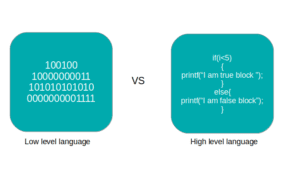When we talk about programming languages, we can categorise them into 2 broad types:
- High level language
- Low level language
The basic difference between these two languages is that a high-level language is programmer-friendly as it is closer to natural language, but it cannot be directly interpreted by machines, whereas, a low-level language can easily be understood by a computer system, but at the same time, the language is difficult to write and understand by a programmer.
Difference between High level language and Low level language in tabular form:
| Basis | High level language | Low level language |
|---|---|---|
| Understandable | A user or programmer can easily understand it as it is more closer to English. Therefore, it is user or programmer friendly | A machine or computer can easily understand it. Therefore, it is machine friendly |
| Dependency | Completely machine independent | Totally machine dependent |
| Translator | It requires a compiler or an interpreter for an effective translation | No translator required, but for Assembly language, assembler is required |
| Program Speed | The code written in High level language must be compiled. Therefore, a translator is required to translate it to low level language. Therefore, the program execution is slower than low-level language | program execution is faster than high-level language |
| Memory efficiency | Least | High |
| Structure | Well structured | Not well structured |
| Debug | Easy to debug | Difficult to debug |
| Portability | Portable | Not portable |
| Manipulation in Code | Easy | Difficult |
| Hardware Knowledge | Not needed | Required |
| Example | C++,Python, Java | Machine language and Assembly Language |
| Application | Websites, Mobile and Desktop Application development | Operating Systems development |
Low level language
A low level language can be described as the language that can easily be understood by a computer or a machine. A low level language is difficult to write, understand and debug. This is the reason, people start moving towards high level languages.
It can be classified into two types assembly language and machine language.
When it comes to modern languages, such as Java and Python, a developer uses IDEs ( Integrated development environment ) to write a source code which can’t be directly understand by the CPU. Rather, the code must be compiled into low level language. It entails low-level languages are faster than the high level languages.
An assembly language can be viewed as a bridge between high level language and machine language as it provides commands such as ADD (Addition ), MUL ( Multiply ) and SUB (subtraction ) that performs certain operations. However, it uses an assembler in order to get converted into machine language.
A machine language is language that consists binary code and the actual code that understand by CPU.
It doesn’t need any translator in order to convert a low level code to native instruction.
High level language
In a nutshell, it can be defined as the language that can easily be understood by a programmer or user. C++, Java and Python are some examples.
These languages are closer to natural language that a human can understand and easy to debug. But, it requires a translator to convert the source code to native code that a computer can interpret.
As already discussed, a program written in high-level language is not capable of executing directly, in order to achieve that, a translator is used which translates the code to machine language. Such as interpreter and compiler.
Key differences
- High level language is the language which is completely machine/computer independent; whereas; Low level language is the language which is totally machine/computer dependent.
- High level languages are also described as the least memory-efficient language; on the other hand, they are highly memory efficient.
- When we talk about High-level then it is important to understand it is very well structured; whereas; in the case of low-level, there is no proper structure that is required to be followed.
- Technically speaking, the high-level languages are always written in some or the other form of English which is not understandable to the machine/computer; whereas; in the case of low-level, they are always in the binary form which is easily understandable to the machine/computer.
- When it comes to High-level then these are very easy to maintain and even manipulate; whereas; when it comes to the low-level then these are very complex in nature and not at all easily maintainable.
- The high-level language will always require a compiler or an interpreter for an effective translation; whereas; the low-level will require an assembler for an effective translation.
- High-level languages are very much portable when it comes to its nature; whereas; the low-level are absolutely non-portable.
- High-level language can also be called as Program-friendly language; whereas; low-level can also be called as Machine-friendly language.
- Moreover, high-level languages are quite easy to debug; whereas; low-level are highly complex to debug.



